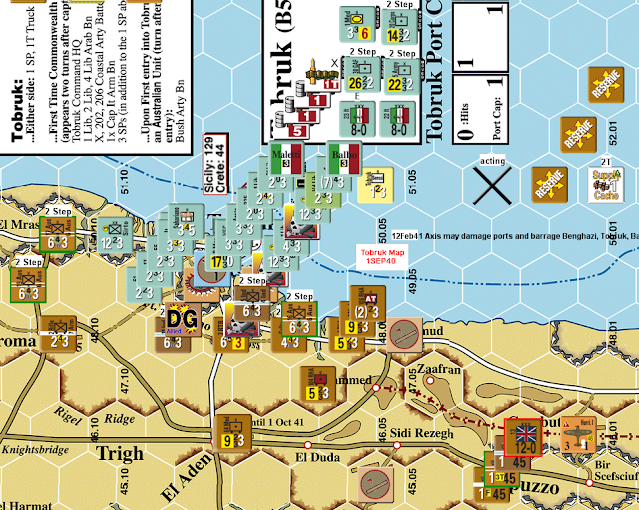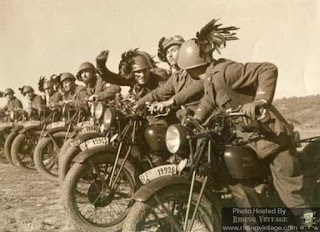Campaign for North Africa Rules Ambiguity
There's lots of minor and not so minor rules ambiguity and contradictions in SPI's Campaign for North Africa. Lots of things are repeated, in slightly different ways.
In my solo Campaign for North Africa house rules I note many with INTERPRETATION. But also have many Additions and Changes (which are opinionated and written for me)
[8.2] The Concept of Continual Movement.
Bold mine. The first sentence makes finished sound like at end of Segment. Second sentence's "its movement" makes finished sound like the end of each unit's movement during a Movement Segment.
In my solo Campaign for North Africa house rules I note many with INTERPRETATION. But also have many Additions and Changes (which are opinionated and written for me)
Here I want to discuss one in particular, from my comment on Campaign for North AFrica BGG AAR thread.
[8.2] The Concept of Continual Movement.
In CfNA, units have Capability Point Allowances [6.0]. Some examples; 10 for infantry. 15-40 for motorized, tanks, recee. Movement, combat, taking replacements and more expend CPA [6.3]. Some examples; 5 perform Close Assault, 3 get Barraged, 1 Attempt to Poison well, <varies> enter hex / cross hexside.
Within a Movement and Combat Phase, the acting player may repeat the four segments 1. Movement, 2. Breakdown, 3. Combat, 4 Reserve Release. As many times as desired and their units have CPA. And under certain restrictions such as:
[8.23] Only those Phasing units that have finished a Movement Segment within two hexes of an enemy unt are free to move again. A Phasing unit that finishes its movement more than two hexes from an enemy combat unit may not continue to move during that Movement Phase...
Bold mine. The first sentence makes finished sound like at end of Segment. Second sentence's "its movement" makes finished sound like the end of each unit's movement during a Movement Segment.
Other instances of inexact phrasing gives weight that the difference is an oversight / sloppy editing. For example; [8.24] saying Break Contact at beginning of M&C Phase while [8.61] states it's beginning of a Friendly Movement Segment. [8.62] states it's beginning of a Movement Segment. [8.64] says beginning of a Movement Segment or Retreat before Assault.
At end of each unit's movement also conceptually matches what I believe Continual Movement is attempting to capture.
[10.24] is an explicit exception to [8.23].
... a unit may always "advance" into an adjacent hex vacated by an Enemy unit as a result of Combat, Retreat Before Assault, or Reaction. Such advance is taken as part of movement in the ensuing Movement Segment...
An example from situation described in BGG AAR thread. 2/17Bn is moving down coast road to get to safety. Kampfgruppe Voss is blocking coast road. The 9thAus is moving up coast road and assaulting Voss to clear it for 2/17. All of that is "happening" simultaneously. But to make a playable game, it's modeled as a sequence of moves.
The simultaneous action plays out (in the reality that game is modelling):
Voss chose not to (or forgot to) React [8.5] allowing 9thAus to move into Contact [8.6]. 9thAus starts a hasty attack (my interpretation of no barraging). Voss getting reports of 2/17 in it's rear decides to GTFO and Retreats Before Assault [13.0], but having already been contacted, must pay extra CPA to Break Off [8.64]. Rainstorms prevent 2/17 from crossing wadi and interdicting Voss' line of retreat.
That was 1st Movement and Combat sequence. Voss "escapes". 9thAus has succeeded in clearing the road.
For the 2nd Movement and Combat sequence; 2/17 (having ended its movement adjacent to enemy) is free to continue down road. 9thAus likewise may chase after Voss. But given CPA of recon units it's probably a folly.
That is, IMHO, the magic and genius of Continual Movement, modelling simultaneous action with a sequence of moves.
But, I'm not convinced my interpretation is correct. I have only used it solo, not playtested with live opponent. It also is less "playable" as one must remember (or use markers) who ended their turn within two hexes. It can lead to more back and forth micro moves.
But, I'm not convinced my interpretation is correct. I have only used it solo, not playtested with live opponent. It also is less "playable" as one must remember (or use markers) who ended their turn within two hexes. It can lead to more back and forth micro moves.



Comments
Post a Comment